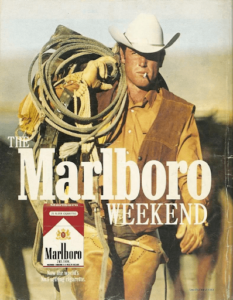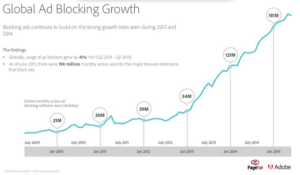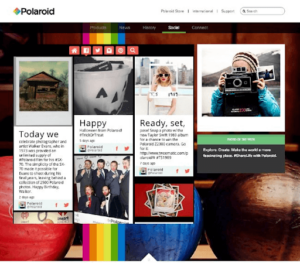Advertising has been around since ancient times, with the Egyptians’ first known examples being steel carvings. Over time, advertising had to evolve to keep up with new technologies and more discerning audiences. Significant milestones such as the invention of the printing press in the 1440s and the subsequent impact of television have played a massive role in this evolution.

The Internet has tremendously affected advertising, transforming it in unprecedented ways. It has not only altered how ads are distributed but also how people respond to them. The web has truly revolutionized the industry of advertising.
Then: Traditional Advertising
Going back to the pre-internet days, advertising used to be done through radio infomercials, fuzzy televisions, and billboards. This period was known as the golden age of advertising, which had become a part of culture and lifestyle.
The revolutionary first TV ad aired in 1941, proving to be a precedent for the following seventy years.
Before the Brooklyn Dodgers and Philadelphia Phillies took to the field, viewers were given a glimpse of a brief commercial advertising Bulova clocks and watches. This small moment marked the beginning of an era!
In the 1950s, advertisements were an integral part of people’s daily lives. Despite America facing challenging times during the Cold War, TV viewers had a sense of hope and optimism as the country began to see economic growth. People started to loosen their purse strings and spend more money.
Characters were constructed to represent brands and products so that viewers would be more likely to form a connection with them. This focus on creating consumer connections was not introduced until later on. Well-known figures and celebrities became famous for promoting items ranging from washing machines to cigarettes.

Take the Marlboro Man as an example, who was a well-known cultural figure between the 1960s and 1990s.
The campaign sought to transform filtered cigarettes from being seen as feminine to more masculine by associating them with rugged cowboys and moody-looking men. To this day, it is considered one of the most successful advertising campaigns of all time.
The Marlboro Man is a prime example of how powerful advertising campaigns can be in connecting with people and creating an iconic cultural figure. Between the 1960s and 1990s, they sought to make filtered cigarettes seem more appealing to men by using rugged cowboys and somber-looking men. This successful campaign is still remembered as one of the most excellent advertisement campaigns of all time.
On television, products and characters became closely associated with each other. For instance, cereal companies have employed memorable mascots like Tony the Tiger for Frosted Flakes and Snap, Crackle, and Pop gnomes for Rice Krispies – which remain popular.

Despite the emergence of various products and distinct characters in ads, all these advertisements had one primary objective: to promote sales.
Though the featured characters were integral to creating an attractive ad culture for consumers, the advertised product remained the primary focus.
It may have appeared that Tony the Tiger or the Marlboro Man were at the heart of their respective advertising campaigns, but they were merely a means to an end — to push sales.
Now: Different Motives
Today, the advertising industry is transitioning from a purely sales-focused approach to prioritizing community building and raising brand awareness.
Product is no longer the centerpiece
Let’s look at an example that refers to the days of character-led advertising. The 2007 Dairy Milk Gorilla commercial didn’t even feature or mention Cadbury, despite being an advertisement for them. The solution to the consumer’s problem was cleverly hidden within it – and what do you know, our product provides that same solution. Ad disaster? No, far from it.
The iconic drum-playing gorilla ad with Phil Collins’s “In the Air Tonight” as its soundtrack against a purple background got people talking. It wasn’t just another product advertisement; it was an attempt by Cadbury to gain awareness and establish itself as a desirable brand to which people would be drawn.
This is why it resonated so well with the public. The advertising of Cadbury was much more than a ploy to get people consumed with buying the chocolate bars; it was an attempt to make Cadbury cool and desirable. This strategy worked, as the ad spread like wildfire and got people talking about the brand. It had achieved its goal by creating awareness and engaging conversations around it.
The straightforward nature of the advertisement encouraged viewers to create their parodies, providing an opportunity for a back-and-forth dialogue with the brand. To date, over 300 spoofs have been created based on this ad.
Lowe’s “Fix in Six” home improvement ads filmed through the 6-second Vine app is a clever way to promote DIY solutions. The fun, easy-to-follow videos provide quick tips and tricks to tackle household tasks. Lowe’s has covered you with their six-second tutorials from simple repair fixes!
The humorous take on home DIY issues has helped Lowe’s create an amiable brand image for its customers, placing it apart from traditional advertising. “Fix in Six” is not overtly associated with Lowe’s either. There is no ‘Hey, this is Lowe’s, and you must purchase everything featured in this advertisement from us’ speech.
Recently, prioritizing a solution to customer problems (such as home DIY) rather than focusing on products has become increasingly commonplace. In the digital world, brands have to work harder to earn customers’ trust; thus, advertising has taken on a two-pronged approach.
- Consumers appreciate helpful content that provides a solution to a problem.
- This encourages them to build trust and a connection with the brand by actively digging for more information.
- It is important to provide helpful, friendly, and authentic content to engage your audience and keep them coming back for more.
From a Passive to Active Consumer: The Biggest Changes
Our TV viewing is still inundated with conventional ads, but rapid evolution is occurring. In the last two decades, more changes have been witnessed in advertising than in the past two millennia – from ancient Egyptians inscribing public declarations onto steel to the 1980s when commercials were an art form.
The ad-blocking revolution is transforming how ads are consumed today. People can now opt out of intrusive commercials, banner ads, and other forms of advertising while online. Consequently, this caused a significant shift in the advertising landscape. We can help you navigate this new age and ensure your business stays ahead of the competition.
People are increasingly choosing to pay for services where they don’t have to be subjected to ads. Estimates suggest that this trend cost publishers a whopping $22 billion in revenue back in 2015. This is an issue that shouldn’t be taken lightly. The rise of tools designed to block ads and the growing popularity of streaming services like Netflix indicate this trend.

It’s high time for advertisers to consider adapting their approaches if they haven’t already, and it’s no secret why.
Consumers need to be more trusting of commercials
Millennials tend to be more discerning when it comes to advertising. A study by Forbes revealed that they often explore blogs and social media to find real-life reviews of products before they commit to purchasing. This emphasizes the need for brands to prove themselves worthy of consumer consideration rather than relying on traditional tactics such as the
Marlboro Man style of advertising. Millennials require a more authentic and solution-oriented approach to make them trust a brand.
Rise of user-generated content
Brands engage with their customers more directly to establish trust and foster loyalty. Consumers have become an integral part of advertising, no longer mere spectators. The distinction between what consumers need from companies and vice versa has been muddied as firms strive to create a sense of community and encourage shoppers to promote their goods (as evidenced by the popularity of sites such as TripAdvisor).
Companies like GoPro are a prime example of this, often relying on user-generated content to advertise their products. To demonstrate this further, take pelicans, for instance.

The most prominent change marketers notice is that they need to focus less on one-time buyers and more on creating a loyal following. People trust each other, not just brands, so loyalty is vital for successful marketing strategies.
Why should companies cultivate a loyal customer base? Because having a devoted following can be one of the most effective forms of marketing. People who love your products will naturally spread the word, creating more interest and helping to drive sales.
Patagonia is a great example – their famous ad campaign encourages customers to return worn items to get repaired rather than buy something new. This is a far cry from the traditional ‘buy and forget’ mentality of the past. In this way, Patagonia has cultivated its army of loyal fans!
Advertising has come a long way since its beginnings in Ancient Egypt, having gone through the introduction of the printing press and the ‘golden age’ of cheesy infomercials. Nowadays, ads are increasingly being replaced by organic ways to build trust and community. But would Marlboro Man’s tactics be successful in
A time when delivering solutions is favored over selling? That would be up to the consumer to decide. In any case, brands offering return policies have a clever dual purpose: it creates customer loyalty and builds trust that their products won’t break easily. After all, why would they offer returns if the product was of poor quality?
Even With this, it’s clear that audiences are doing all they can to avoid ads. They have the power when it comes to what they do and don’t buy.
Innovations that preceded the apparition of digital marketing
Digital marketing may be a relatively new field, but its existence was only possible with the IT innovations that came before it. Listed below are some of the most influential IT advancements that made digital marketing possible:
- The Internet: enabling marketers to reach a large audience with their marketing message.
- Social Media platforms like Facebook and Twitter: provide brands with a way to connect with customers and build a two-way dialogue.
- Mobile Devices: allowing brands to target their market wherever they are.
- Analytics tools: helping Marketers track results and optimize campaigns for better ROI.
Forecast for 2023
It was only yesterday that we were forecasting the future of advertising and how technology will change how we view and compose ads. Now, as a new decade approaches, let’s take another glance at the marketing environment and see how much it has transformed – and will keep on transforming – over the upcoming years.
Regarding technology, some key aspects will considerably affect advertising in 2023. AI and ML usage are set to keep growing amongst certain brands to develop personalized and precise ads. AR and VR will also be employed more regularly for sales strategies and product demonstrations. Moreover, blockchain will likely become incorporated into advertising, with some platforms utilizing it to confirm ad impressions and avoid deception.
In general trends, 2023 will be the year mobile overtakes desktop as the most popular medium for web browsing. This means that more people than ever before will be looking at content on their phones and tablets, so advertisers need to ensure they are designing mobile-friendly ads.
Social media will continue to be a vital platform for reaching consumers and tracking engagement. Video – both live streaming and pre-recorded – is expected to become an essential part of any marketing strategy.
To sum up, brands must be ready to include new technologies and patterns if they want to remain ahead. Failing to do so could quickly leave them behind, and that is something no advertiser desires.
Click here If You are Looking for Digital Marketing Jobs
QUESTIONS AND ANSWERS
Q: What are the fundamental advances that made digital marketing possible?
A: The internet, social media platforms like Facebook and Twitter, mobile devices, and analytics tools were all instrumental in making digital marketing an option.
Q: How will technology likely impact advertising in 2023?
A: We expect AI and ML to be used more frequently for personalized ads, AR and VR for sales purposes, and blockchain to be incorporated into advertising platforms.
Q: What must brands do to stay ahead?
A: Brands must incorporate new technologies and trends to stay ahead of the competition in 2023. Failing to do so could leave them behind.
Q: How can brands optimize their digital marketing strategy?
A: Brands should focus on creating mobile-friendly ads, leveraging social media tools to track engagement, and embracing video content such as live streaming and pre-recorded videos.
Q: What are the advantages of digital marketing?
A: Digital marketing allows marketers to reach a wider audience and engage in two-way customer conversations. It also provides access to analytics tools that help track results and optimize campaigns for better ROI.





